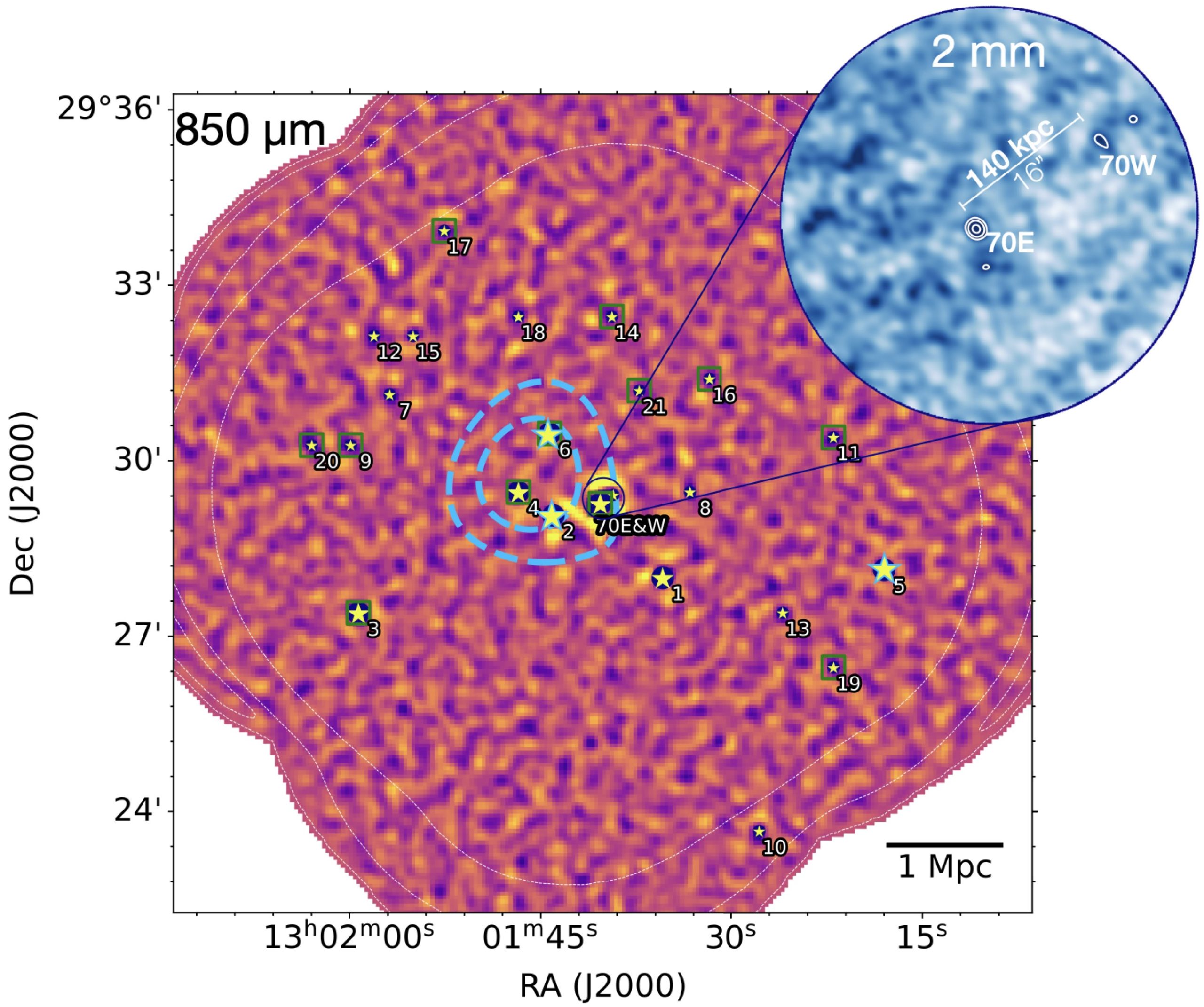Dusty star-forming galaxies can trace cosmic overdensities
The evolution of the cosmic star formation rate density paints a dynamic picture of galaxy evolution, with rapid stellar build-up at redshifts above 2, followed by a stark drop in SFRs of galaxies towards the present day. The origins of this down-turn are likely due to a mixture of feedback processes, broadly categorized as caused by environmental (strangulation, harassment, and ram-pressure stripping) and internal (star formation and active galactic nuclei) quenching effects.
Cosmic overdensities form pockets where the Universe is matter-dominated, and can trace galaxy evolution in more extreme environments, where the processes that characterize star formation (i.e. fueling and feedback) happen on faster time-scales and at earlier epochs. Notably, models predict that the majority of high-redshift star formation occurs in overdense environments, where the compact regions drive gas away by environmental quenching through processes of gas stripping and the cessation of infalling gas that feeds star formation. Meanwhile, the rapid evolution of galaxies can trigger active galactic nuclei that disrupt gas flow and star formation from within.
Hydrodynamical and parametric models of galaxy clusters predict that the intracluster medium (ICM) becomes too warm to readily collapse on to galaxies at redshifts 3–5, needing to form cold streams that fuel star formation until z ∼ 2−3. Cold flows could still persist further into the local Universe; however, their extent might be more limited. This generic picture then predicts rapid quenching through a lack of fueling of the central galaxies, resulting in passive galaxy clusters at redshift 0. In particular, this sudden lack of inflowing gas in dense environments at z ∼ 2.5 allows for a unique test of galaxy quenching.
Studies into the properties of these protocluster galaxies, however, find varying properties from protocluster to protocluster. The galaxy populations within protoclusters appear diverse, and we are currently limited in our understanding through a sheer lack of identified high-z protocluster environments. This diversity, however, could also be a selection bias, since protoclusters are found across the entire electromagnetic spectrum, from UV, optical to radio, each of which are likely sensitive to a specific galaxy population and therefore to a specific phase of cluster evolution.
Dusty star-forming galaxies (DSFGs) are known to trace some of the most active star-forming regions in the Universe, with very short gas depletion time-scales. Observational studies have shown a strong connection between these galaxies and their wider circum-galactic medium rapidly enriching their environments while also showcasing examples of gas feeding at z ∼ 2−3. Environmental studies of DSFGs also help characterize the evolution of the massive end of star formation, as DSFGs are the likely progenitors of massive ellipticals, which could help identify potential environmental effects in order to explain recent observations of massive quenched galaxies being found at z ∼ 4.

Follow-up observations of luminous high-redshift galaxies detected in large surveys such as Herschel, in particular using submillimetre facilities, have enabled to identify candidate protoclusters by resolving the sources in multiple galaxies at similar redshift. A recent example is the z-GAL survey that measured, using the NOrthern Extended Millimetre Array (NOEMA), precise spectroscopic redshifts of 135 dusty, bright Herschel-selected galaxies. In some cases, the fields displayed multiplicity and revealed candidate protoclusters. One example is the Herschel galaxy H-ATLAS J130140.2 + 292918 (HerBS-70), which was revealed by the NOEMA observations to be a binary system of DSFGs at z = 2.3, where the east component (HerBS-70E) hosts an AGN.
Now, a team of researchers reports 1 on deep continuum observations at 850 μm of the environment around HerBS-70 using SCUBA-2 on the James Clerk Maxwell Telescope (JCMT) and targeted NOEMA spectroscopic measurements of the most likely protocluster candidates in the field.
The researchers describe the continuum map observations using the SCUBA-2 instrument on the JCMT and spectroscopic observations using NOEMA at 2 mm, including the reduction steps, flux extraction, completion and flux boosting estimates. The SCUBA-2 observations detected, in addition to the binary system, 21 sources. The surface density of continuum sources around HerBS-70 is three times higher than for field galaxies.
The NOEMA spectroscopic measurements confirm the protocluster membership of three of the nine brightest sources through their CO(4–3) line emission, yielding a volume density 36 times higher than for field galaxies.
All five confirmed sub-mm galaxies in the HerBS-70 system have relatively short gas depletion times (80−500 Myr), indicating the onset of quenching for this protocluster core due to the depletion of gas. The dark matter halo mass of the HerBS-70 system is estimated around 5 × 1013 M⊙, with a projected current-day mass of 1015 M⊙, similar to the local Virgo and Coma clusters.
These observations support the claim that DSFGs, in particular the ones with observed multiplicity, can trace cosmic overdensities.
Author: César Tomé López is a science writer and the editor of Mapping Ignorance
Disclaimer: Parts of this article may have been copied verbatim or almost verbatim from the referenced research paper/s.
References
- Tom J L C Bakx, S Berta, H Dannerbauer, P Cox, K M Butler, M Hagimoto, D H Hughes, D A Riechers, P P van der Werf, C Yang, A J Baker, A Beelen, G J Bendo, E Borsato, V Buat, A R Cooray, L Dunne, S Dye, S Eales, R Gavazzi, A I Harris, D Ismail, R J Ivison, B Jones, M Krips, M D Lehnert, L Marchetti, H Messias, M Negrello, R Neri, A Omont, I Perez-Fournon, A Nanni, N Chartab, S Serjeant, F Stanley, Y Tamura, S A Urquhart, C Vlahakis, A Weiß, A J Young (2024) A dusty protocluster surrounding the binary galaxy HerBS-70 at z = 2.3, Monthly Notices of the Royal Astronomical Society doi: 10.1093/mnras/stae1155 ↩